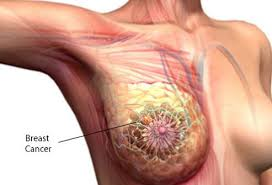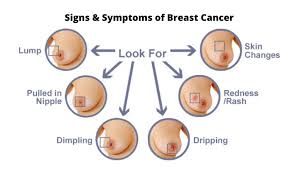A cancer that forms in the cells of the breast.common between age 40-50.
PRECIPITATING FACTORS
- Unmarried women
- nulliparous women
- women with bad obstrectic history
- high in oral contraceptives
SYMPTOMS
- lumb in the breast
- bloody discharge from breast
- changes in shape or texture of the nipple or breast
CLASSIFICATION
a) intra dochal -within the ducts
b) extra dochal-outside the ducts
CLINICAL TYPES
1.Invasive duct carcinoma-common form ,lumb is very broad &irregular causes drowning of the nipple .
2. Medullary carcinoma-primary tumors is soft and circumscribed and may attain a large size
3. Colloid CA/Tubular CA – Appear as well defined masses common in elderly
4.Inflammatory CA – Seen usually during pregnancy and lactation.Breast is often painful
5. Technical Types
Mastitis Carcinoma:i.e carcinoma + inflammation ;retracted nipple;skin is red ,warm and painful
MANCHESTERS STAGING OF THE BREAST CANCER
Stage 1 – Growth confined to breast;An area of adherence to the skin smaller than the periphery of the tumor does not affect staging.Even ulceration of the skin in the area defined does not alter it
Stage 2 – same as stage 1 but palpable,mobile,lymph node gathering of growth to the pectoral muscle
Stage 3 – skin involvement larger than tumor. Tumor fixed to pectoral muscle.if the nodes are palpable they must be mobile
Stage 4 –
- Skin involvement as stage 3
- Tumor fixed to chest wall
- Axillary nodes are not mobile
- Palpable nodes in supra clavicular fossa
- Secondary deposits in skin
- Secondary deposits in the opposite breast
- Distant metastasis
The physician or surgeon can easily notice certain peculiar features in the breast in the conditions of any breast cancer
1. Peu-d-orange
2. Oedema of the arm
3. Browny arm
4. Development of carcinomatous nodules on the affected side of the chest wall .
SPREAD OF CANCER
1.Local spread – From mammary gland to skin muscles and chest wall
2. Lymphatic Spread – Leading to inflammatory of internal mammary lymph nodes,supraclavicular node,axillary lymph nodes etc…
3. Spread by Blood Stream – To ribs ,lumbar vertebra, femur,thoracic vertebrae, to the skull,may lead to pathological fractures
4. Spread to liver – May lead to jaundice
5. Transcoelomic spread
INVESTIGATIONS
a) Needle biopsy/FNAC
b)Trephine biopsy
c)Open biopsy
d)Frozen section biopsy
e)Mammography
f)Ductography
g)Thermography
TREATMENTS
- hormonal
- endocrine manipulations
- radio therapy
- oestrogen blockers
- immuno therapy
- chemo therapy
At present ,radical mastectomy or extended radical mastectomy offers the prospect of long survival provided the neoplasm categorized as belonging to stage 1 and stage 2 .when stages 3 and 4 are reached,the interests of the patient are best served by simple mastectomy and radiotherapy provided the tumor is hormone stimulated ,with endocrine therapy.
RADICAL MASTECTOMY (halsted)
The breast and associated structures are dissected enblock, and the excised mass is composed of
- The whole breast
- A large portion of skin ,the centre of which overlies the tumor ,but always included the nipple,where there is much skin involvement more skin must be sacrificed
- The fat and fascia from the tumor border of the clavicle to,including the upper quater of the sheath of the rectus abdominis and from the sternum to the anterior border of the latismus dorsi
- pectoralis major,and its fascial sheath
- pectoralis minor and sheath
- the costo-coracoid membrane
- all the fat,fascia and lymph nodes of the axilla
- the fascia over and a few fibres of the external oblique,serratus anterior subscapularis ,the latismus dorsi and the upper part of the rectus abdominis
2)Extended radical mastectomy
In this ,the radical mstectomy along with removal of internal mammory lymph glands and second inter costal muscle
For getting opinion from our network hospitals visit mvtbooking.com or send a email to query.gtsmeditour.com



Post a comment